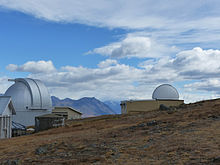astro.wikisort.org - Institution
University of Canterbury Mount John Observatory (UCMJO), previously known as Mt John University Observatory (MJUO), is New Zealand's premier astronomical research observatory.[1] It is situated at 1,029 metres (3,376 ft) ASL atop Mount John at the northern end of the Mackenzie Basin in the South Island, and was established in 1965.[1] There are many telescopes on site including: one 0.4-meter, two 0.6-meter, one 1.0-meter, and a new 1.8-meter MOA Telescope. The nearest population center is the resort town Lake Tekapo (pop. <500). Approximately 20% of nights at MJUO are photometric, with a larger number available for spectroscopic work and direct imaging photometry.
 UC Mount John Observatory at the top of Mount John | |||||||||||
| Organization | University of Canterbury | ||||||||||
|---|---|---|---|---|---|---|---|---|---|---|---|
| Observatory code | 474 | ||||||||||
| Location | Mount John, South Island, New Zealand | ||||||||||
| Coordinates | 43°59.2′S 170°27.9′E | ||||||||||
| Altitude | 1,029 metres (3,376 ft) | ||||||||||
| Weather | 20% of nights photometric | ||||||||||
| Established | 1965 | ||||||||||
| Website | UC Mt John Observatory | ||||||||||
| Telescopes | |||||||||||
| |||||||||||
| | |||||||||||

UCMJO is operated by the University of Canterbury, and is the home of HERCULES (High Efficiency and Resolution Canterbury University Large Echelle Spectrograph), and the observational wing of the Japanese/New Zealand MOA collaboration (Microlensing Observations in Astrophysics) led by Professor Yasushi Muraki of Nagoya University. A Japanese funded, 1.8-meter telescope is now in place and will be used initially by the MOA Project, before handover to the University of Canterbury at the conclusion of the MOA Project in 2012.
In June 2012 an area of 430,000 hectares (1,700 sq mi) around the observatory was declared as the Aoraki Mackenzie International Dark Sky Reserve by the International Dark-Sky Association, one of only four such reserves around the world.[2] The area has a Bortle Scale of 2.[3]
Facilities
There are 5 large telescopes on the mountain that are in regular use. There is also a cafe and night-tours run by tourist operators, Earth and Sky. There is accommodation for visiting researchers within the 1.0m building. A Superintendent lives on the mountain.
MOA Telescope
Opened in 2004 December, this telescope was built by Japanese astronomers and is dedicated to the MOA project. It is a 1.8m prime focus reflector. The MOA telescope is the largest telescope in New Zealand.
McLellan Telescope
This is a 1.0m Dall-Kirkham reflecting telescope run at either f/7.7 or f/13.5. Photometric imaging is by CCD camera and spectroscopy is by fibre-optic cable to the HERCULES spectrograph.
The McLellan Telescope is named after Professor Alister George McLellan who was the Head of Department at Canterbury University from 1955 to 1985. He was instrumental in the development of the Mt John Observatory and when it opened in 1965 he was appointed its first Director.
Boller & Chivens Telescope
This is a 0.61m reflecting telescope run at either f/13.5 or occasionally f/6.25. Photometry is usually carried out using an FLI CCD camera.
Optical Craftsmen Telescope
This is a 0.61m fork mounted reflecting telescope operating at f/16. This telescope is used exclusively for CCD photometry. It is currently being upgraded and commissioned for robotic use as part of the AAVSO's Robotic Telescope Network. This is the AAVSO's first Southern Hemisphere telescope.
Earth and Sky Telescope
This telescope, used exclusively for visual tourist operations is a 0.4m Meade LX200 telescope.
Discoveries
In June 2008 it was reported at the meeting of American Astronomical Society that using their new MOA-II telescope, the observatory discovered what is at the time the smallest planet known outside of our Solar System. The planet MOA-2007-BLG-192Lb is just 3.3 times larger than Earth and is orbiting a small star, MOA-2007-BLG-192L (3000 light years from Earth). There is some possibility the planet has a thick atmosphere and a liquid ocean on its surface.[4]
References
- Rae, Sally (4 August 2009). "A tranquil trip to Lake Tekapo". Otago Daily Times. Retrieved 4 August 2009.
- "New Zealand's Aoraki Mackenzie Named World's Largest International Dark Sky Reserve" (PDF). International Dark Sky Association. 9 June 2012. Archived from the original (PDF) on 10 July 2012. Retrieved 13 June 2012.
- An Application to the International Dark-Sky Association for a Starlight Reserve in the Aoraki/Mt Cook National Park and the Mackenzie Basin of the central South Island of New Zealand (PDF). Mackenzie District Council, University of Canterbury, Royal Astronomical Society of New Zealand, Department of Conservation. 27 January 2012. p. 25. Archived from the original (PDF) on 9 November 2017.
- Rincon, Paul (2 June 2008). "Tiniest extrasolar planet found". Astronomers have sighted the smallest extrasolar planet yet orbiting a normal star – a distant world just three times the size of our own. BBC News. Retrieved 3 June 2008.
External links
- Mount John University Observatory - current webpage
- Mount John University Observatory - 2004 webpage
- HERCULES website
- MOA website
- Stars in a Cluster and other documents relating to the Observatory on archive.org
На других языках
[de] Mt John University Observatory
Das Mt John University Observatory (MJUO) ist Neuseelands führendes Observatorium. Es wurde 1965 eingerichtet und befindet sich auf dem Mount John, 1029 Meter über N.N. im nördlichen Teil des Mackenzie-Beckens auf der Südinsel von Neuseeland. Die Betreiberin des Observatoriums ist die University of Canterbury in Christchurch.- [en] Mount John University Observatory
[ru] Университетская обсерватория Маунт Джон
Университетская обсерватория Маунт Джон — астрономическая обсерватория, основанная в 1965 году на горе Джон, около озера Текапо (регион Кентербери, Новая Зеландия). Обсерватория является крупнейшей обсерваторией Новой Зеландии и принадлежит Кентерберийскому университету.Другой контент может иметь иную лицензию. Перед использованием материалов сайта WikiSort.org внимательно изучите правила лицензирования конкретных элементов наполнения сайта.
WikiSort.org - проект по пересортировке и дополнению контента Википедии
